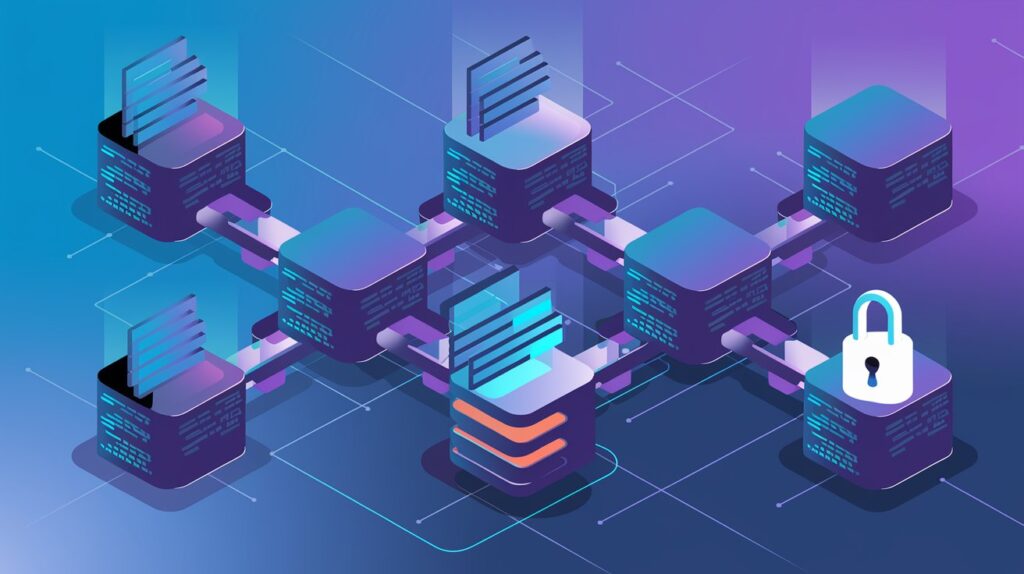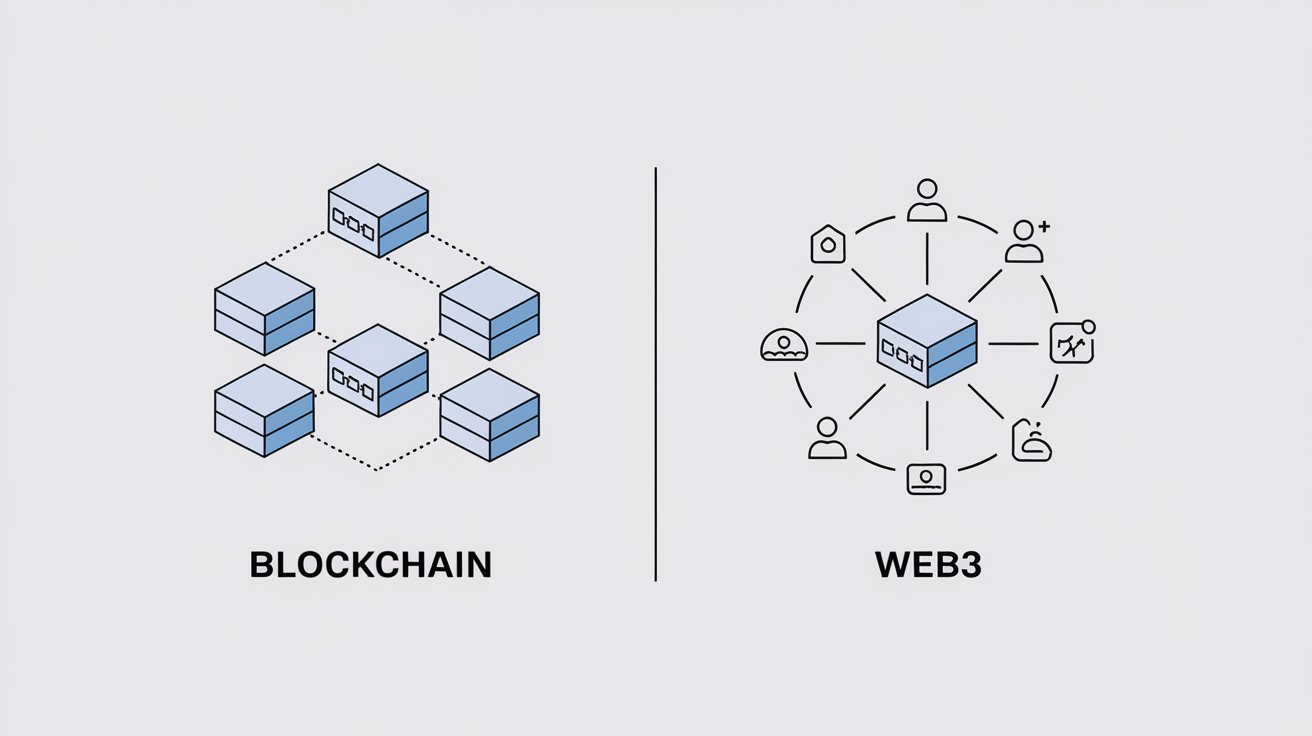The terms “Blockchain” and “Web3” have become buzzwords in tech, but what do they really mean, and how are they different? Well, Blockchain provides the Technical backbone, Then Web3 is the Vision. A decentralized internet built on transparency, security, and user empowerment. Understanding their identities can help us understand how they might reshape our digital world.
Table of Contents
Blockchain: The Backbone of Decentralization

Blockchain is a Distributed ledger technology that’s designed to record and verify transactions without needing a central authority. Data is stored in blocks and linked in chains, which allows a certain integrity (once data is added, it cannot be changed). Each participant in the blockchain network, holds a copy of the ledger also called them “Node” and helps confirm transactions through consensus mechanisms.
Blockchain’s Key Features:
Decentralized Structure: Unlike traditional systems where a single entity has the control. Instead, everyone in the network holds a share of the information.
Security and Transparency: With data stored across multiple nodes and cryptographic protections in place. Thus, Blockchain ensures high security, preventing fraud and unauthorized tampering data.
Inflexible Data: For each transaction, once they added to a node, is nearly impossible to alter. This feature creates a trusted environment for data, for this kind of technology it’s very useful in areas like finance, healthcare, and supply chain.
Blockchain’s influence is visible in Bitcoin and Ethereum. They both leverage this decentralized ledger to allow secure and peer-to-peer transactions. Through blockchain, users worldwide can send or receive funds without a middleman like banks or payment processors. In sectors like supply chain management, blockchain can trace goods transparently from its origin to destination. Which reduce fraud and reinforcing trust.
Web3: Construction a User Controlled Internet
Blockchain lays down the foundation, but Web3 extends this concept offering a decentralized internet where users have full control over their personal data, identity, and digital assets. Web3 applications, or “dApps” (Decentralized Apps), operate on blockchain technology but introduce user based ecosystems. But it’s more than simply recording transactions, aiming to create a world where users are active participants in the services they consume.
Web3 Key Features:
User Data Control: Unlike on Web2 where data is often exploited for money. Users own their personal data and can share or monetize it as they please.
Decentralized Apps (dApps): These applications operate autonomously without a central server, allowing for trestles transactions and more privacy.
Economic Incentives through Tokens: Web3 platforms often have native tokens for rewarding or incentivizing users. This decentralized economy allows users to earn, trade, or invest, thus it creates a more inclusive digital economy.
Think about platforms like Brave and Filecoin. Brave is a Web3 browser that allows users to earn cryptocurrency by choosing to view ads, while Filecoin enables decentralized data storage, offering users to rent out unused storage for tokens. These cases highlight Web3’s significance on user authorities and data control over traditional models.
Difference Between Blockchain and Web3
Blockchain is the framework, while Web3 is the concept of a decentralized internet. Here’s a closer look at the main differences:
Purpose and Functionality
Blockchain’s main function is to serve as a secure, distributed ledger that records data with transparency and integrity. It’s ideal for tracking assets or verifying transactions.
Web3, However is more than just record keeping. This is a change in how the internet operates, users connect, interact, and transact with each other, without intermediaries.
Scope and Utilization
Blockchain is often limited to few specific applications, like cryptocurrencies and data verification. It mostly used in financial technology (FinTech), healthcare, and supply chain sectors.
Web3 seeks to change the whole internet experience, from social media and file storage to gaming and finance. It integrates multiple decentralized applications to build a user driven, privacy respecting ecosystem.
For example, In DeFi (Decentralized Finance) blockchain enables secure, fast transactions without banks. But Web3 platforms like Uniswap add another layer, allowing users to exchange tokens and earn fees without any central authority involved. This freedom has made finance available to millions worldwide, but it’s the Web3 ecosystem that truly creates a community driven, decentralized exchange, not just the blockchain alone.
How Blockchain and Web3 Are Changing the Future
Privacy and Data Ownership
With Web3, user data stays in the user’s hands. In contrast to traditional platforms like Facebook or Google, Web3 applications let users decide how their data is used, shared, or monetized. Blockchain ensures data security and integrity. Making Web3’s vision possible by providing a tamper proof foundation.
Economic Empowerment
Web3’s token driven economy encourages user participation, This system letting them earn tokens for contributions. This model turns consumers into stakeholders, enable power distribution from large corporations to individuals. Web3 drive a more comprehensive and unbiased economy, having blockchain means being able to secure digital assets and transactions.
Accessibility and Integration
Traditional finance has left millions unbanked, but blockchain and Web3 create solutions for those who lack access to financial services. Through Decentralized Finance (DeFi) platforms like Aave or Compound, users can lend, borrow, or save without a bank. It’s a profound shift, with analysts predicting blockchain driven financial integration will improve financial access in developing regions.
Ethical Concerns and Administrative Challenges
Rapid Innovation vs. Regulation
As blockchain and Web3 continue to evolve, they pose significant challenges for regulators. With no central authority in Web3, ensuring compliance is tough. Many governments worry about privacy risks and the potential for illegal activities, as blockchain can mask identities.
Calls for Balanced Regulation
Experts suggest that governments should adopt flexible and adaptive regulations rather than imposing restrictive laws that suppress innovation. The European Union’s MiCA regulation (Markets in Crypto Assets) is a step in this direction, this aim to set standards for crypto and blockchain firms without compromise growth.
The Synergy Between Blockchain and Web3: A Powerful Duo for Decentralization
While blockchain and Web3 may sound like similar concepts, the two actually work together to provide a secure and decentralized ecosystem. Alternative to conventional digital forms of communication and interaction. The groundwork for Web3’s vision of a decentralized user controlled internet is built out with blockchain.
Potential Impact on Digital Ownership
The NFT (Non Fungible Token) market shows how this synergy works: Blockchain secures digital ownership, while Web3 platforms create marketplaces where artists, gamers, and consumers can interact without intermediaries. In 2021 alone, NFTs reached over $40 billion in value, indicating the scope of the market of digital ownership delivered through blockchain and Web3.
Future of Digital Identity
In Web3 and blockchain, there is the promise of a digital identity revolution. Instead of a Facebook or Google login, users can use blockchain based wallets to access services, protecting their privacy and reducing dependency on centralized platforms.
Conclusion:
Blockchain and Web3 are more than just technological developments. They might be the game changer for how we view data, privacy, and economic systems. By building a decentralized framework, blockchain enables Web3’s goal of an open and fair internet. As the technology advances, blockchain and Web3 may redefine ownership, finance, and even identity in the digital world.
For students, businesses, and everyday users, understanding these technologies now will be key to navigating the future of a decentralized internet. And while challenges remain, from legal barriers to ethical questions, the possibilities are endless. The journey of blockchain and Web3 is just beginning and the future looks bright.




Thank you for your sharing. I am worried that I lack creative ideas. It is your article that makes me full of hope. Thank you. But, I have a question, can you help me?
Thanks for sharing. I read many of your blog posts, cool, your blog is very good.
Thank you for your sharing. I am worried that I lack creative ideas. It is your article that makes me full of hope. Thank you. But, I have a question, can you help me?
Thanks for sharing. I read many of your blog posts, cool, your blog is very good.
Thank you for your sharing. I am worried that I lack creative ideas. It is your article that makes me full of hope. Thank you. But, I have a question, can you help me?
Thank you for your sharing. I am worried that I lack creative ideas. It is your article that makes me full of hope. Thank you. But, I have a question, can you help me?
Thank you for your sharing. I am worried that I lack creative ideas. It is your article that makes me full of hope. Thank you. But, I have a question, can you help me? https://accounts.binance.com/ES_la/register-person?ref=T7KCZASX
I don’t think the title of your article matches the content lol. Just kidding, mainly because I had some doubts after reading the article.
Your article helped me a lot, is there any more related content? Thanks! https://accounts.binance.com/en-NG/register?ref=JHQQKNKN
I don’t think the title of your article matches the content lol. Just kidding, mainly because I had some doubts after reading the article.
Your article helped me a lot, is there any more related content? Thanks! https://accounts.binance.com/ES_la/register?ref=T7KCZASX
Can you be more specific about the content of your article? After reading it, I still have some doubts. Hope you can help me.
Can you be more specific about the content of your article? After reading it, I still have some doubts. Hope you can help me.
Can you be more specific about the content of your article? After reading it, I still have some doubts. Hope you can help me. https://accounts.binance.com/en-IN/register?ref=UM6SMJM3
Thank you for your sharing. I am worried that I lack creative ideas. It is your article that makes me full of hope. Thank you. But, I have a question, can you help me? https://accounts.binance.com/en-IN/register-person?ref=UM6SMJM3
Your article helped me a lot, is there any more related content? Thanks!
Can you be more specific about the content of your article? After reading it, I still have some doubts. Hope you can help me.
I don’t think the title of your article matches the content lol. Just kidding, mainly because I had some doubts after reading the article.
Your article helped me a lot, is there any more related content? Thanks!
Your article helped me a lot, is there any more related content? Thanks!
Can you be more specific about the content of your article? After reading it, I still have some doubts. Hope you can help me.
Thank you for your sharing. I am worried that I lack creative ideas. It is your article that makes me full of hope. Thank you. But, I have a question, can you help me?
Thank you for your sharing. I am worried that I lack creative ideas. It is your article that makes me full of hope. Thank you. But, I have a question, can you help me? https://www.binance.com/pl/register?ref=YY80CKRN
Your article helped me a lot, is there any more related content? Thanks!
Thanks for sharing. I read many of your blog posts, cool, your blog is very good. https://accounts.binance.info/register?ref=P9L9FQKY
Thanks for sharing. I read many of your blog posts, cool, your blog is very good.
Your point of view caught my eye and was very interesting. Thanks. I have a question for you.